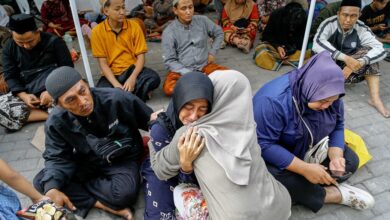
A volcano on the Indonesian island of Bali has rumbled into life with a series of eruptions that temporarily disrupted some international flights to the popular tourist destination and dusted nearby resorts and villages with a thin layer of ash.
Mount Agung erupted on Saturday evening and three times early Sunday, lighting its cone with an orange glow and sending ash 4,000 meters (13,000 feet) into the atmosphere. It is still gushing and the dark gray clouds are moving toward the neighboring island of Lombok, a direction that is away from Bali’s airport, where nearly all scheduled domestic and international flights were continuing Sunday.
Australian airline Jetstar, which canceled nine flights to and from Bali on Saturday evening, said most of its flights will operate normally Sunday after its senior pilots assessed it was safe to fly. However it warned that the movement of ash cloud is highly unpredictable and flights could still be canceled at short notice. Virgin, KLM and Air Asia Malaysia also canceled several flights Saturday.
“All flights are back to normal,” said Herson, head of the local airport authority, who uses one name.
Disaster officials said ash up to half a centimeter (less than an inch) thick settled on villages around the volcano and soldiers and police were distributing masks.
Authorities warned anyone still in the exclusion zone around the volcano, which extends 7.5 kilometers (4.5 miles) from the crater in places, to leave.
Made Sugiri, an employee at Mahagiri Panoramic Resort some 10 kilometers (6 miles) from the crater, said a thin layer of volcanic ash reached the area.
“We are out of the danger zone, but like other resorts in the region, of course the eruptions cause a decrease in the number of visitors,” he said.
“I think these latest eruptions are more dangerous, given the thick clouds it’s releasing,” he said. “Certainly we worry, but we have to wait and see. Hopefully there is no significant eruption.”
Government volcanologist Gede Suantika said a red-yellow light visible in ash above the mountain was the reflection of lava in the crater. Suantika said Agung could spew ash for at least a month but did not expect a major eruption.
Bali is Indonesia’s top tourist destination and its gentle Hindu culture, surf beaches and lush green interior attract about 5 million visitors a year.
Several thousand people were affected by Saturday’s flight cancellations.
“We weren’t notified by Jetstar in advance of us getting here (to Bali’s airport),” said Australian tourist George Bennick. “So we are very disappointed about that.”
Agung also had a minor eruption on Tuesday but authorities have not raised its alert status from the second highest, which would widen the exclusion area and prompt a large evacuation of people.
About 25,000 people have been unable to return to their homes since September, when Agung showed signs of activity for the first time in more than half a century.
The volcano’s last major eruption in 1963 killed about 1,100 people.
Indonesia sits on the “Pacific Ring of Fire” and has more than 120 active volcanoes.
Mount Agung’s alert status was raised to the highest in September following a dramatic increase in tremors from the volcano, which doubled the exclusion zone around the crater and prompted more than 140,000 people to leave the area. The alert was lowered on Oct. 29 after a decrease in activity.




